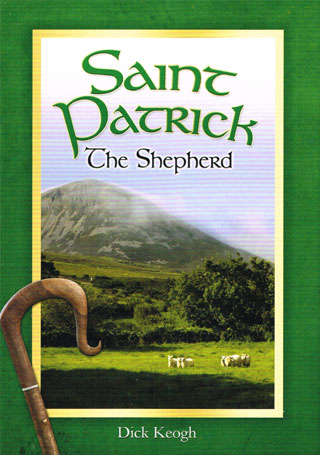
THE YOUNG SHEPHERD
The image of Saint Patrick, holding in his hand a shepherd’s crook, is portrayed in many pictures and statues. This image symbolises the care of the shepherd. It also reminds us of the care of Jesus, the Good Shepherd, who died on the cross.
Patrick was brought up in Britain in a Christian home where he heard the Gospel message. However, he was rebellious and had no interest in spiritual matters. When he was sixteen years old his life took an unexpected turn. A party of Irish raiders attacked his father’s estate. They killed some of the servants and took others captive. Patrick was also taken. The prisoners were transported to Ireland and sold as slaves. Patrick’s life would never be the same again. Having been reared on a wealthy estate, he was now reduced to being exhibited as a piece of merchandise and offered for sale to the highest bidder. The man who bought him was a sheep farmer who soon put his slave to work. According to his writings, Patrick endured a lot of hardship as he looked after the sheep. This included hunger and persecution and resulted in him being ‘near to the point of death’.
THE SHEPHERD’S RESPONSIBILITIES
To Nurture the Sheep
As a shepherd, Patrick was responsible for the wellbeing of the sheep in his care. To maintain a large flock the sheep needed to be moved from pasture to pasture, thus ensuring fresh grass and clear, pure water. He was responsible for each individual member of the flock. Often Patrick would examine his sheep to see if they were healthy and strong, or injured, sick, weak or weary.
To Protect the Sheep
Sheep were vulnerable and were unable to defend themselves against marauders. Tribes of vicious Irish natives regularly raided farms, stealing livestock. Wolves and wild dogs roamed the fields and hills of Ireland at that time and sheep, especially newborn lambs, were easy prey. As a shepherd, Patrick always had to be on the alert for such dangers.
To Rescue the Sheep
Every good shepherd counted his sheep each morning and evening as they were prone to wander. Often they became lost and were unable to find their way back to the safety of the sheepfold and the tender care of their shepherd. So regardless of circumstances, Patrick, the shepherd, would set out to rescue the sheep that had gone went astray.
These were great responsibilities for Patrick who had been abducted by raiders, taken to a foreign country and sold as a slave. Life was not easy for the young shepherd at that time, but very soon his life would take another unexpected turn.
The image of Saint Patrick, holding in his hand a shepherd’s crook, is portrayed in many pictures and statues. This image symbolises the care of the shepherd. It also reminds us of the care of Jesus, the Good Shepherd, who died on the cross.
Patrick was brought up in Britain in a Christian home where he heard the Gospel message. However, he was rebellious and had no interest in spiritual matters. When he was sixteen years old his life took an unexpected turn. A party of Irish raiders attacked his father’s estate. They killed some of the servants and took others captive. Patrick was also taken. The prisoners were transported to Ireland and sold as slaves. Patrick’s life would never be the same again. Having been reared on a wealthy estate, he was now reduced to being exhibited as a piece of merchandise and offered for sale to the highest bidder. The man who bought him was a sheep farmer who soon put his slave to work. According to his writings, Patrick endured a lot of hardship as he looked after the sheep. This included hunger and persecution and resulted in him being ‘near to the point of death’.
THE SHEPHERD’S RESPONSIBILITIES
To Nurture the Sheep
As a shepherd, Patrick was responsible for the wellbeing of the sheep in his care. To maintain a large flock the sheep needed to be moved from pasture to pasture, thus ensuring fresh grass and clear, pure water. He was responsible for each individual member of the flock. Often Patrick would examine his sheep to see if they were healthy and strong, or injured, sick, weak or weary.
To Protect the Sheep
Sheep were vulnerable and were unable to defend themselves against marauders. Tribes of vicious Irish natives regularly raided farms, stealing livestock. Wolves and wild dogs roamed the fields and hills of Ireland at that time and sheep, especially newborn lambs, were easy prey. As a shepherd, Patrick always had to be on the alert for such dangers.
To Rescue the Sheep
Every good shepherd counted his sheep each morning and evening as they were prone to wander. Often they became lost and were unable to find their way back to the safety of the sheepfold and the tender care of their shepherd. So regardless of circumstances, Patrick, the shepherd, would set out to rescue the sheep that had gone went astray.
These were great responsibilities for Patrick who had been abducted by raiders, taken to a foreign country and sold as a slave. Life was not easy for the young shepherd at that time, but very soon his life would take another unexpected turn.


